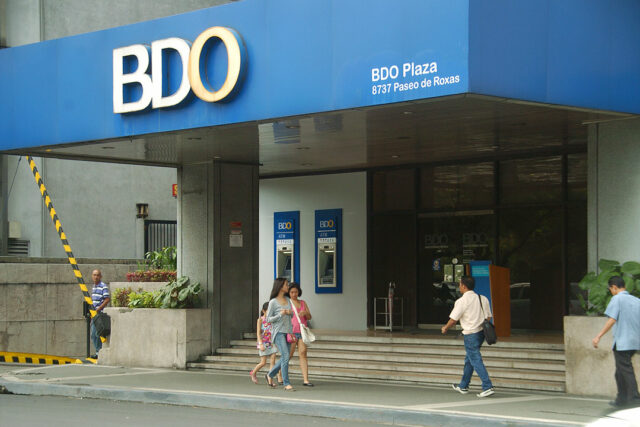Gov’t makes full award of reissued 20-year bonds
THE GOVERNMENT made a full award of the reissued 20-year Treasury bonds (T-bonds) it offered on Tuesday amid strong demand and as the average rate fetched was largely in line with secondary market levels on expectations that headline inflation eased anew in August.
The Bureau of the Treasury (BTr) raised P30 billion as planned via the reissued 20-year bonds it auctioned off on Tuesday as total bids reached P49.435 billion, well above the amount on offer.
This brought the outstanding volume for the series to P121.1 billion, the Treasury said in a statement.
The bonds, which have a remaining life of three years and one day, were awarded at an average rate of 6.025%. Accepted yields ranged from 5.975% to 6.05%.
The average rate of the reissued papers went up by 1.6 basis points (bps) from the 6.009% fetched for the series’ last award on July 30. Still, this was 260 bps lower than the 8.625% coupon for the issue.
This was likewise 2 bps above the 6.005% seen for the same bond series and 0.8 bp higher than the 6.017% quoted for the three-year bond — the tenor closest to the remaining life of the papers — at the secondary market before Tuesday’s auction, based on PHP Bloomberg Valuation Service (BVAL) Reference Rates data provided by the BTr.
The government made a full award of its T-bond offer as rates fetched were largely in line with market expectations, a trader said in a text message.
“This bond looks attractive, especially at above 6%, since the longer securities are just a few basis points higher,” the trader said.
“The Treasury bond average auction yield at 6.025% is almost the same as the comparable three-year PHP BVAL yield of 6.02% as of Sept. 3… ahead of the latest headline inflation data that is expected to ease back to within the Bangko Sentral ng Pilipinas’ (BSP) target range of 2-4%,” Rizal Commercial Banking Corp. Chief Economist Michael L. Ricafort said in a Viber message.
Slowing inflation would give the BSP confidence to cut benchmark interest rates further, which could match potential easing moves by the US Federal Reserve in the coming months, Mr. Ricafort added.
Philippine headline inflation likely eased last month and returned within the central bank’s 2-4% annual target amid lower prices of rice and fuel, analysts said.
A BusinessWorld poll of 15 analysts yielded a median estimate of 3.7% for the August consumer price index (CPI), within the BSP’s 3.2-4% forecast.
If realized, the August CPI would be slower than the nine-month high of 4.4% seen in July and the 5.3% print in the same month a year ago.
The Philippine Statistics Authority will release August inflation data on Thursday (Sept. 5).
With inflation likely on a downtrend, analysts expect that the central bank will be able to continue its easing cycle.
The BSP last month cut benchmark interest rates for the first time in almost four years amid an improving inflation and economic outlook, with its governor signaling at least one more reduction before the end of the year.
The Monetary Board on Aug. 15 reduced its policy rate by 25 bps to 6.25%.
BSP Governor Eli M. Remolona, Jr. said they could cut rates by another 25 bps within the year. The Monetary Board’s last two policy-setting meetings this year are on Oct. 17 and Dec. 19.
Meanwhile, markets widely expect a rate cut at the US central bank’s Sept. 17-18 meeting following Fed Chair Jerome H. Powell’s dovish speech at the Jackson Hole Symposium last month.
Mr. Powell last month endorsed an imminent start to interest rate cuts, saying further cooling in the job market would be unwelcome and expressing confidence that inflation is within reach of the US central bank’s 2% target.
“The time has come for policy to adjust,” Mr. Powell said in a highly anticipated speech to the Kansas City Fed’s annual economic conference in Jackson Hole, Wyoming. “The direction of travel is clear, and the timing and pace of rate cuts will depend on incoming data, the evolving outlook, and the balance of risks.”
Futures are 100% priced for a cut of 25 bps this month, and imply a 33% probability of 50 bps, Reuters reported. They also have 100 bps of cuts priced in by December, and 120 bps for 2025.
Crucial for the Fed will be the payrolls report on Friday, where analysts look for a rise of 165,000 in jobs and a dip in the unemployment rate to 4.2%.
The BTr wants to raise P195 billion from the domestic market this month, or P80 billion through Treasury bills and P115 billion via T-bonds.
The government borrows from local and foreign sources to help fund its budget deficit, which is capped at P1.48 trillion or 5.6% of gross domestic product for this year. — A.M.C. Sy with Reuters















